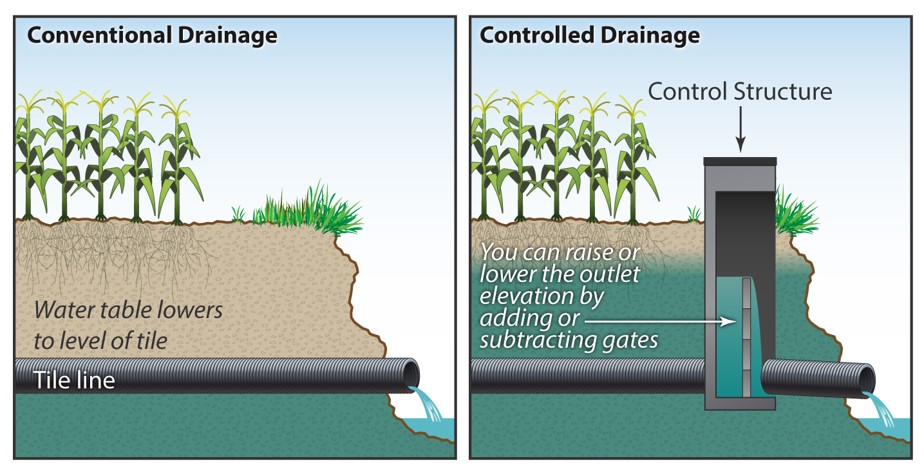Director’s Desk
Advanced Conservation Drainage Training in Illinois
About the training:
The 2019 Advanced Conservation Drainage Training (ACDT) Program brings together diverse members of the agricultural and drainage communities and provides them with knowledge, tools, and connections to make conservation drainage an integral part of tile installation and farm management. Our 2019 series will focus on three conservation drainage practices: saturated buffers, constructed wetlands, and drainage water management. Through classroom exercises, field demonstrations, and expert-led discussions, participants will learn about the science behind how each practice works, gain technical knowledge associated with siting, designing, and constructing conservation drainage practices, and develop strategies to successfully implement practices while overcoming common administrative challenges.
We are recruiting a diverse cadre of trainees (drainage contractors, farmers, engineers, agency experts, crop consultants, etc.) to enhance the learning experience and create a strong, continuing network of regional experts.
Workshops are scheduled throughout Central IL on the dates below:
June 19-20: Saturated buffer training and field day (Champaign)
July 24-25: Constructed wetland training and field day (East Peoria)
August 7: Drainage water management training and field visit (Decatur)
More information: https://ilsustainableag.org/programs/advanced-conservation-drainage-training/
Registration form: https://form.jotform.com/almarino/2019-acdt-application
NRCS Seeks Comments
ADMC responded to the NRCS request for comments on the National Conservation Practice Standards. I would like to thank all members who helped to provide insight and edits to the ADMC comments. Click here to view the comments that were submitted.
Keegan Kult ADMC Executive Director

ADMC Diamond Members
Conservation Drainage Opportunities in the Western Lake Erie Basin
In February 2019 Ohio voters passed a ballot initiative to grant Toledo citizens the right to file lawsuits on behalf of Lake Erie. There has been an increased occurrence of harmful algal blooms which led to the Ohio Lake Erie Phosphorus Task Force setting a 40% phosphorus loss reduction goal for the Western Basin of Lake Erie. The potential impact that phosphorus, especially dissolved phosphorus, can have on a lake ecosystem was culminated during the 2014 Toledo drinking water crisis. A group of Toledo citizens felt that the goals of the task force and the state of Ohio’s 2017 Collaborative Implementation Framework would not be enough to protect Lake Erie, which brought about the 2019 vote to grant the lake rights. The successful ballot initiative has since been challenged in court and it is unknown whether it will stand. What is known is that agriculture must increase the rate of adoption and implementation of proven conservation practices for the voluntary approach outlined by the task force and implementation framework to remain a viable option.
To achieve the 40% phosphorus loss reduction goal, the Ohio Lake Erie Phosphorus Task Force laid out a road map of voluntary best management practices. The list of practices includes both in field and edge of field management solutions. Widescale adoption of in-field practices such as nutrient and manure management, reduced tillage systems, cover crops need to be complimented by an equal scale of adoption for conservation drainage and streamside buffers.


The same soils and landscape in Ohio that creates the need for artificial drainage has also created great potential for implementing conservation drainage practices. The USDA-NRCS estimates that there are 2.1 million acres of land that well suited for drainage water management (DWM) in Ohio. DWM is a practice that uses a control structure to manage the outlet height of a drainage system to control the amount and timing of discharge. Controlling the amount of discharge has been shown to decrease nitrate load export by 44% and dissolved phosphorus load by 40-68%. By managing the water, producers have also realized up to 10% boosts in yields during certain growing seasons.
In addition to Ohio being a great a fit for DWM, a recent ADMC report showed that Ohio has 43,000-62,000 potential sites suitable for saturated buffers. This equates of up to 1.6 million drained acres being treated by a saturated buffer which would remove upwards of 7,250 tons of nitrate or 14% of the estimated nitrogen load stemming from Ohio’s tile drained landscape.
To aid with the installation of the needed best management practices, the Ohio Department of Agriculture is providing $23.5 million to Soil and Water Conservation Districts through the 2018 Ohio Senate Bill 299. The funding will be divided among three new assistance programs, including the Cost Share and Equipment Buy Down program which covers control structures for DWM. The EPA has also recently awarded the Ohio EPA $1.48 million for water quality protection. Ohio has already demonstrated success in utilizing financial assistance programs to install control structures. An estimated 1,000 control structures were installed from 2013-2017 using the state funded Clean Lakes Initiative and federally funded Great Lakes Basin Initiative/RCPP. These 1,000 control structures likely represent 20,000-25,000 acres managed with control drainage. 25,000 acres is a great start but is only about 1% of the area suitable for controlled drainage in Ohio.
There is a road map of practices that provide solutions to phosphorus concerns and funding available to implement the practices. Now it is up to landowners to continue to utilize the programs and advisers to educate the landowners on what is possible. Ohio is not unique in its need to increase the speed of implementation to reach needed water quality goals on a voluntary basis, but it has experienced its catalyst event with the 2014 Toledo drinking water crisis that stresses the importance of reaching the goal.
ADMC Welcomes New Silver Member
 J. Pettiecord, Inc. has joined ADMC as a new member at the Silver level. They are an Iowa based company that specializes in large-scale land clearing, wood waste grinding, construction and demolition grinding, underground storage tank removal, contaminated soil removal, demolition, heavy haul trucking, dump trucking and snow removal. Also experts at hazardous material cleanup, the Pettiecord crew is prepared for any long-range, short-term or emergency project. They support ADMC’s efforts as they supply woodchips for bioreactors which are screened free of fines. ADMC would like to thank J. Pettiecord, Inc. for their support and look forward to building the relationship.
J. Pettiecord, Inc. has joined ADMC as a new member at the Silver level. They are an Iowa based company that specializes in large-scale land clearing, wood waste grinding, construction and demolition grinding, underground storage tank removal, contaminated soil removal, demolition, heavy haul trucking, dump trucking and snow removal. Also experts at hazardous material cleanup, the Pettiecord crew is prepared for any long-range, short-term or emergency project. They support ADMC’s efforts as they supply woodchips for bioreactors which are screened free of fines. ADMC would like to thank J. Pettiecord, Inc. for their support and look forward to building the relationship.
Conservation Drainage Events
Share on twitter
Twitter




